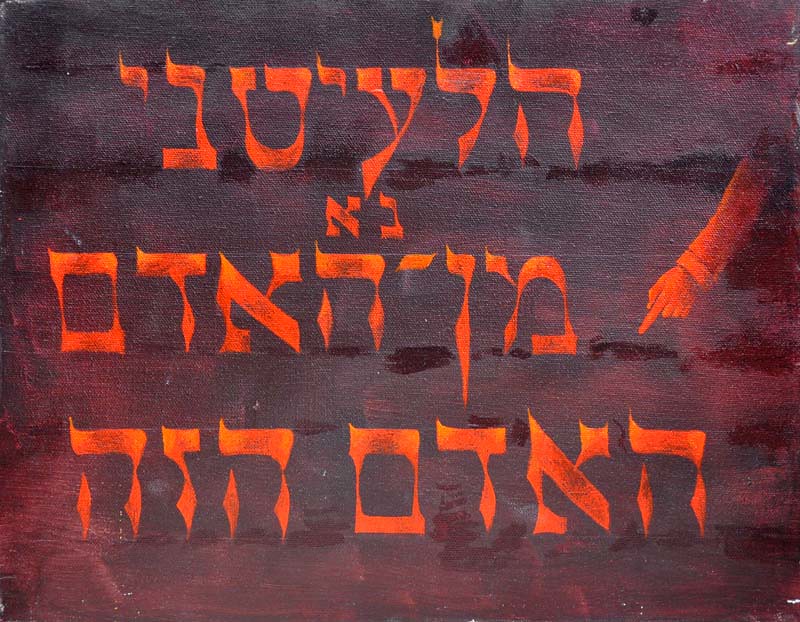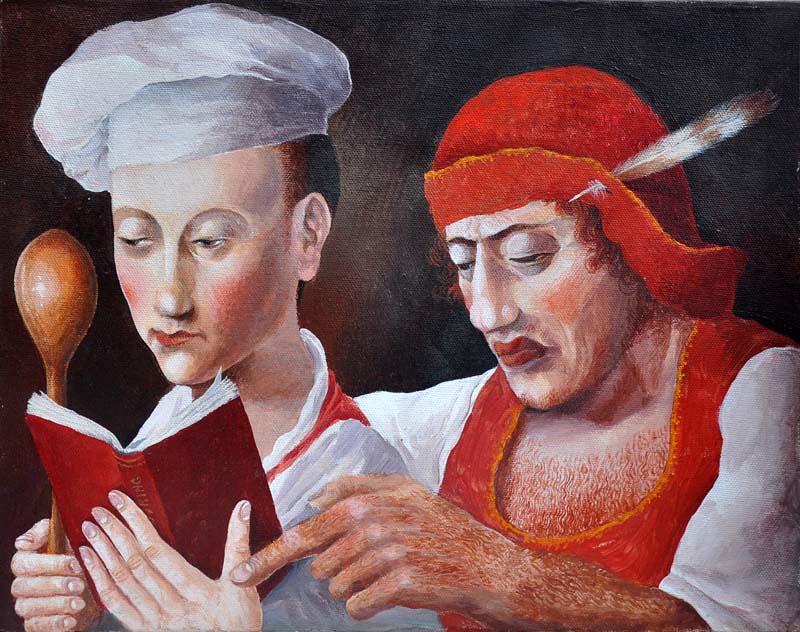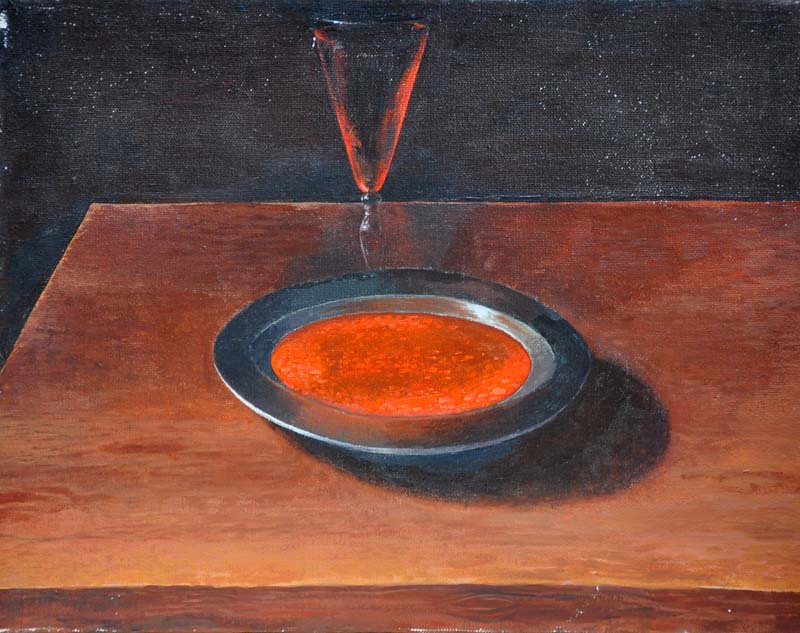Перед вами живописная часть концептуального проекта, выполненная в середине 90-х годов для несостоявшейся групповой выставки в Музее Израильского Искусства в Рамат-Гане. Речь идет о том наивном периоде жизни и деятельности автора, когда он считал важным вступить в прямую интеракцию с современным ему искусством государства Тель-Авив (в миру: Израиль).
После невероятного успеха проекта «Улица Бограшов» в Тель-Авиве, в рамках которого инсталляция Н.Зингера «Памяти Робинзона Крузо» была разрушена до основания на близлежащем пляже в ночь перед открытием и восстановлена из обломков в день оного в галерее «Бограшов», последняя была немедленно закрыта, а ее руководительница Ариэла Азулай назначена главным куратором вышеназванного музея. В первом сезоне ею было объявлено о проведении двух концептуальных групповых выставок, к участию в которых были привлечены, среди прочих участников последнего уличного начинания (см. выше), Гали-Дана и Некод Зингер. Очевидно, благодаря участию в обоих проектах этих художников, госпожа Азулай не позднее, чем через полгода после назначения была смещена также и со своего поста в музее, а намеченные ею выставки отменены. Самообвинение Г.-Д. и Н.З. основывается не на мании величия, как то мог бы заподозрить неосведомленный сторонний наблюдатель, но на прикладном применении теории вероятностей. Дело в том, что год спустя они были официально приглашены осуществить персональный проект в Музее Герцлии, в рамках серии выставок молодых концептуалистов, в результате чего музей был поставлен на трехлетний капитальный ремонт, а куратору серии Хаиму Луски отказано в реализации всех намеченных планов. Не желая зла и без того испытывающему немалые трудности прогрессивному израильскому искусству, Г.-Д. и Н.З. решили впредь не принимать приглашения участвовать в проектах отечественных музеев.
Выставка, для которой, как говорилось выше, Некодом Зингером была изготовлена данная серия картин (акриловые краски на холсте, 35Х27 см. каждая) носила кодовое название “Do it”и намечалась как часть широкой международной акции, суть которой заключалась в том, что несколько ведущих европейских художников нео-концептуалистов, мировых звезд первой величины, имена которых не сохранились в памяти Г.-Д. и Н.З., о чем последнему до сих пор ни разу не представилось случая сожалеть, давали младшим по чину участникам набор достаточно строго определенных и регламентированных заданий, из которых каждый должен был выбрать одно и воплотить ниспосланную свыше идею, сообразно степени своего послушания и местным условиям. Задания эти помнятся сейчас лишь частично. Одно из них требовало написать какое-то руководство и дать его скопировать последовательно наибольшему возможному числу людей, а затем выставить все варианты. Другое, названное «Любовь к красному», требовало разместить на каких-то определенных участках пола в галерее красные предметы. И так далее… Анархистское желание взорвать изнутри это тоталитарно-бюрократическое построение, подвигло Г.-Д. и Н.З. на создание «грязного», совершенно персонального, концепта, объединяющего все команды всех инструкторов (кажется, их было от семи до десяти) и тем самым сводящего на нет их попытку столь дешевыми средствами присвоить себе право первородства. Как ни странно, этот концепт, основанный на широко известной, грязноватой и до сего дня смущающей многих библейской истории о чечевичной похлебке, был принят израильским куратором, за что она, как уже было сказано, и поплатилась. Единственное, что осталось от неосуществленного проекта, кроме данных холстов, это воспоминание о том, что в красных квадратах на полу музея должны были находиться полиэтиленовые мешочки с красной чечевицей (музей был готов выделить бюджет на покупку 10 кг., в то время как Н.З. требовал не менее 20), а также о том, что наглядное пособие по приготовлению чечевичной похлебки (илл. №5) было последовательно скопировано четырьмя людьми, прежде чем последовал отбой.
Древнееврейский текст на илл. №1 гласит: «Дай мне поесть красного, красного этого…» (In King James’ Bible: Feed me, I pray thee, with that same red pottage… (Genesis, 25:30))
На илл. №5: «Чечевичная похлебка» (Lentil pottage) Приятного аппетита!»
Опубликовано на сайте Ассоциация "Антиподы"In English1

2

3

4

5
 Денис Безносов. Искусство как таковое или ОНО САМОЕ (о выставке «Чистый концепт: Цвет. Звук. Линия»)
Денис Безносов. Искусство как таковое или ОНО САМОЕ (о выставке «Чистый концепт: Цвет. Звук. Линия»):
Заглавие серии художественных работ Некода Зингера «Грязный концепт» полемизирует с общим заглавием выставки. За основу цикла работ, действительно, взят «грязный концепт» - библейская история о чечевичной похлебке, до сих пор воспринимаемая довольно неоднозначно.
Серия картин задумывалась как часть концептуальной выставки середины 90-х, так и не осуществившейся в Музее Израильского Искусства в Рамат-Гане. «Грязный концепт» – это экспрессивный вызов, интеллектуальное противодействие окружающей действительности. «Анархистское желание взорвать изнутри это тоталитарно-бюрократическое построение, подвигло Г.-Д. и Н.З. (Гали-Дана Зингер и Некод Зингер. – Д.Б.) на создание «грязного», совершенно персонального, концепта, - сообщает автор, - объединяющего все команды всех инструкторов (кажется, их было от семи до десяти) и тем самым сводящего на нет их попытку столь дешевыми средствами присвоить себе право первородства».
«Грязный» натуралистично-экспрессионистский концепт цикла Некода Зингера выполнен в красных тонах. Отсюда второе заглавие – «Любовь к красному» – связанное с цитатой на древнееврейском языке, приведенной в первой иллюстрации цикла: «Дай мне поесть красного, красного этого…». В конце серии «Грязного концепта» приведено наглядное пособие по приготовлению той самой чечевичной похлебки.














